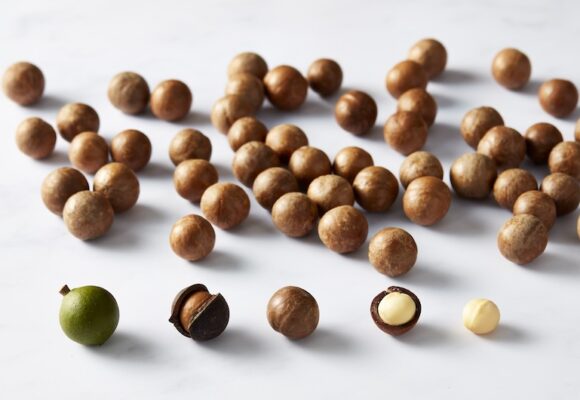Australian Macadamias recently commissioned a large-scale consumer research study, surveying people across Australia, China, Japan, South Korea, the USA and India. The goal? To understand current attitudes toward food, health, and wellbeing, particularly when it comes to macadamias.

The study consisted of more than 6,000 online interviews with respondents aged 18-74 years of age who had consumed nuts in the past six months, were their household’s primary shopper, and were aware of macadamias.
In the first instalment of this two-part series, we explored broader consumer trends in diet, snacking and nutrition. Now, we turn the focus to macadamia-specific insights, highlighting key opportunities for food and beverage manufacturers looking to innovate with this premium ingredient.
The power of macadamias as an ingredient
Macadamias are more than just a snack, they’re a sought-after ingredient. When asked if they had ever purchased a product because it contained macadamias, more than 80% of consumers said they had.
The top response globally was chocolate coated nuts at 33%, closely followed by baked goods at 32.5% and then chocolate bars or blocks at 28%. Almost one quarter (24%) said they’d bought an ice cream or gelato product because it contained macadamias.

Market-specific preferences also emerged:
- In the USA, baked goods dominate (45%), arguably driven by the enduring popularity of white chocolate macadamia cookies
- In China, nut-based milk (32.5%) and nut butters (30%) rank highly alongside chocolate-coated nuts and baked goods
- South Korea skews toward cereals and granola (22%) and protein bars (21.5%), alongside chocolate-coated nuts.
- More than 90% of Indian consumers reported purchasing a product specifically because it contained macadamias, with strong results across multiple categories.
Consumers want more macadamia innovation
The demand for macadamias extends beyond current product availability. When asked which products they’d like to see feature macadamias as an ingredient more often, more than a quarter of consumers globally said:
- Baked goods (36%)
- Chocolate-coated nuts (35%)
- Chocolate bars and blocks (32%)
- Ice cream and gelato (28%)
- Cereals and granolas (26%)

The study revealed the biggest opportunity gaps to be in ice-cream and gelato, cereal and granolas, brownies, nut butters and spreads, chocolate bars and blocks, protein bars and energy balls, and even yoghurts.
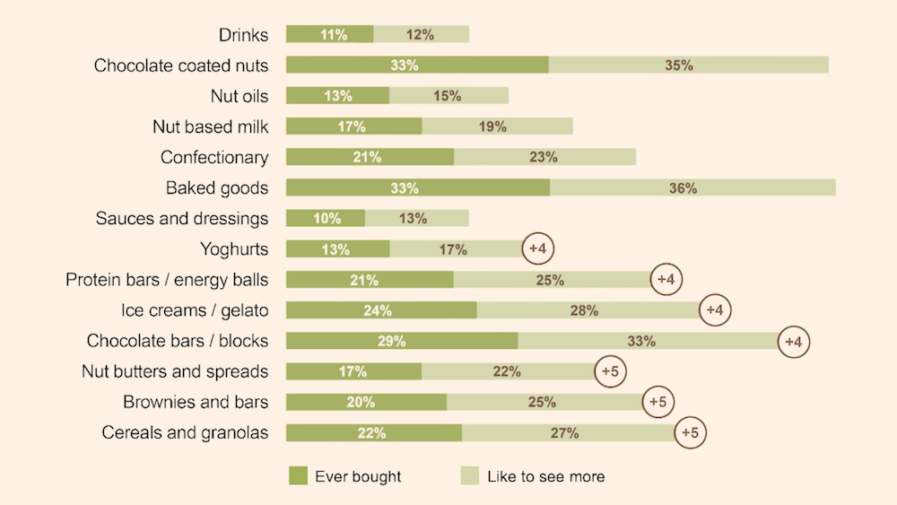
From a market-specific perspective, there were several noteworthy insights. While a large proportion of American consumers said they had already purchased baked goods because they contained macadamias, 45% said they still want to see macadamias used more often in this category. This market also indicated a strong desire to see macadamias used in more brownies and bars (34%).
In China, nut-based milks (29%) and nut butters (28%) featured in the top 4 products they most want to see include macadamias as an ingredient, signalling growing interest in plant-based dairy alternatives.
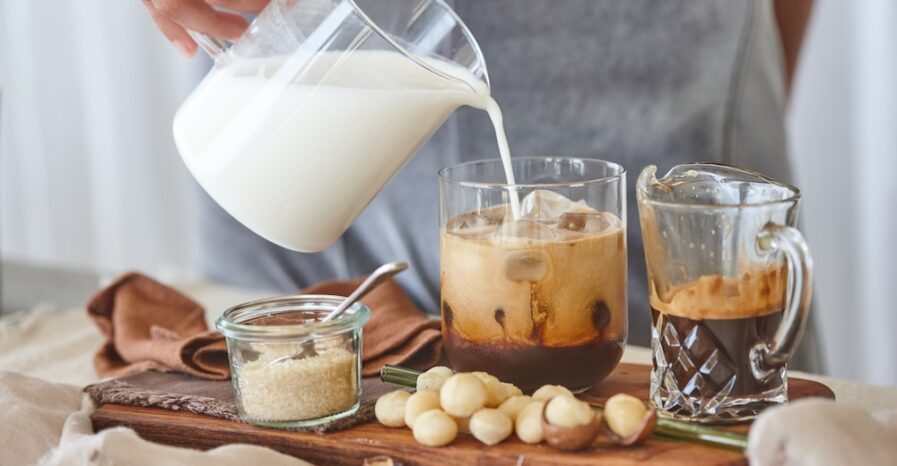
Japanese consumers have long had an appetite for chocolate-coated macadamias, but it seems they have room for more, with 40% saying they want to see more macadamias in chocolate-coated nut products. 31% said they wanted to see macadamias included in other confectionery products as well.
In South Korea, cereals and granolas (28%) rank highest, followed by protein bars and energy balls (24%) and chocolate bars and blocks (24%).
Indian consumers signalled overwhelming demand, with more than 95% wanting more macadamia-containing products across multiple categories.
The premium and indulgent appeal of macadamias
Macadamias hold a distinct position in consumers’ minds as a luxury nut:
- 33% globally associate macadamias with luxury, higher than any other nut
- Macadamias also ranked strongly as a premium nut (34%)
- More than one quarter say macadamias are the best nut for gifting, reinforcing their role in premium food offerings
Macadamias are also seen as indulgent, healthy, and delicious. While ‘healthy’ and ‘tasty’ were the most common associations, regional preferences emerged:

- In China, ‘delicious’ was the dominant descriptor
- In Japan and South Korea, ‘chocolate’ was strongly linked to macadamias
These perceptions feed into the reasons people consume macadamias, with most nominating taste (58%) followed by their abundant nutrients (43%). Consumers in India said their top reason for consuming macadamias was their high quality (63%).
How people are using macadamias
Macadamias have become part of everyday eating habits and respondents reported incorporating them in various ways:
- As a snack on their own (34%)
- To boost health and wellbeing (32%)
- Within another purchased product (29%)
- As a cooking ingredient in baked goods (27%)
- As a cooking ingredient in meals (22%)

These uses were even more prominent in India with snacking at 42%, health boost at 44%, within another product purchased and as a cooking ingredient for baking both at 35%, and as a cooking ingredient in meals at 35%.
In China, macadamias outperformed all other nuts in key usage categories:
- 49% consumed macadamias as a stand-alone snack, far surpassing the next most popular nut at 39%
- Macadamias led for ‘health and wellbeing boost’ consumption (49%), well ahead of the next most popular option at 31%
- Other common uses include as a cooking ingredient in meals or baked goods (both 37%), as a nut butter (39%) or nut milk (37%), and as a topping (34%)
The occasions (and people) that prompt macadamia purchase
The study delved into the occasions that prompt consumers to buy or eat macadamias, with the results highlighting the nut’s versatility.
When purchasing macadamias, snacking was the primary purpose globally, although there were nuances across markets. American consumers said the main reason they bought macadamias was to make cookies, in Japan it was as a souvenir or as an alcohol accompaniment, while Indian shoppers said gifting, festivals and Diwali.
When asked to consider all usage occasions, relaxing alone emerged as the most popular response at 52%, following by casual gatherings with family and friends (34%) and taking a break from work or study at home (31%). For Australian and American consumers, celebrations and parties featured in their top three occasions. In India, most occasions scored higher than 30% indicating an eagerness to incorporate macadamias into a range of different moments.
In terms of who main grocery buyers are purchasing macadamias for, most said they’re buying for themselves (95%) or their partner (39%). In China, the second most popular response was for guests at 35%, and respondents from this market also had more school-aged children (5-11 years) eating macadamias than the other countries surveyed at 26%. In India, teenage children are consuming macadamias more so than in other markets (37%).
Treat moments unpacked
Given that macadamias have a strong association with luxury, we wanted to better understand how consumers incorporate them into their treat moments.
This uncovered the insight that people turn to macadamias when they’re looking for:
- A healthy treat (44%)
- An occasional treat (44%)
- A mood boost (33%)
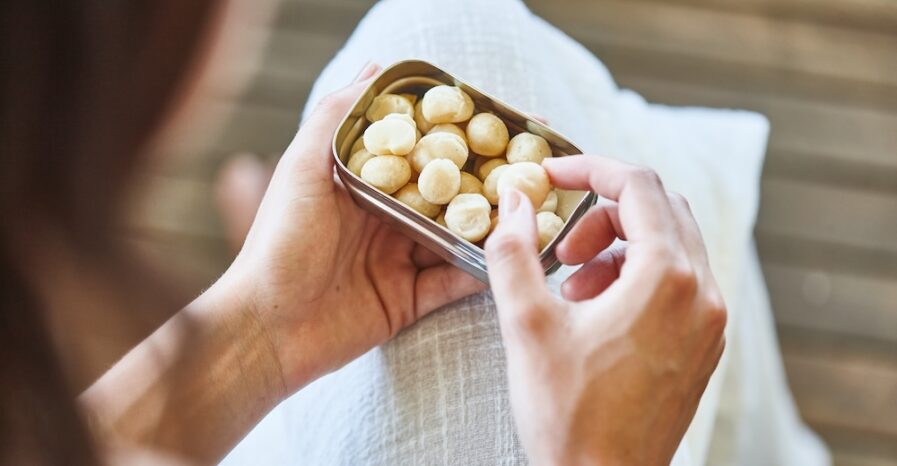
The link between macadamias and healthy treats was even stronger in India (65%) and China (53%). Mood-boosting treat moments also ranked highly in both of these markets as macadamia consumption occasions, with China at 48% and India at 57%.
First bite: how consumers discover macadamias
Many Australian consumers can strongly recall the first time they tried a macadamia, however the research revealed that this is surprisingly common in other markets too, underscoring the unique sensory experience macadamias deliver.
Market-specific insights reveal unique discovery patterns.
In Australia, many people recalled childhood memories of cracking fresh macadamias in the backyard, during a trip to Queensland or enjoying them at Christmas. “When I first moved to Queensland we had a macadamia tree in our yard. Someone told me that they were delicious, and the rest is history.”
In the USA, there are strong ties to Hawaii and first trying macadamias in cookies or chocolate. “My grandma took me to Hawaii where they are put in chocolate.”
Many consumers in China reported being introduced to macadamias through friends or family. “I was first introduced to macadamia nuts at a friend’s party. Everyone was sitting around chatting. There was a plate of mixed nuts on the table. I picked up a round and plump nut and tasted it.”
In Japan, many recounted their first macadamia experience in the form of Hawaiian souvenirs. “I received chocolate macadamia nuts as a souvenir from Hawaii from someone at work.”
South Korean consumers have tended to discover macadamias via health-related media, others through chocolate pairings or social interactions. “I learned from a TV program that it is a very healthy food.”
Indian consumers were typically introduced through friends or learned about them online before purchasing. “I was watching a reel about a farmer who grows macadamia nuts, I was inspired by him and thought to buy the nuts.”
Macadamia consumption is set to grow
Consumers are not only satisfied with macadamias, many plan to buy more. 90% globally expect to purchase the same amount or more over the next year.
- China leads the way with 97% planning continued or increased purchases
- India follows closely at 91%, with 40% expecting to buy significantly more macadamias driven largely by their health benefits
- High satisfaction levels reinforce this trend: 73% globally report being extremely satisfied with their recent macadamia purchases, rising to 87% in China and 93% in India
Country of origin matters
Consumers are paying attention to where their macadamias come from, with 59% globally saying origin is important when purchasing macadamias. This sentiment is even stronger in Australia (62%), China (90%) and India (79%).
Awareness of Australian-grown macadamias is high:
- 65% of all respondents know macadamias are grown in Australia
- This was higher in Australia at 79%
- 96% of Chinese and 88% of Indian consumers are aware of Australian-grown macadamias, and more than half prefer to buy them
- 69% of all respondents believe Australian macadamias taste better, with higher confidence in China (87%) and India (91%)
- 73% believe Australian macadamias are of superior quality, rising to 92% in China and 94% in India
- More than half (51%) of the survey’s respondents knew macadamias are native to Australia, with this awareness significantly higher in India at 77% and China at 89%
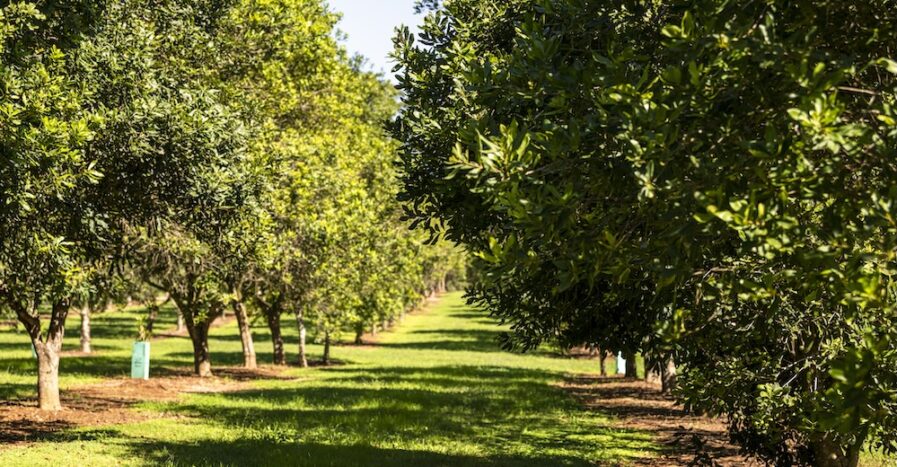
What’s next?
The growing appetite for macadamias signals significant opportunities for food manufacturers and brands looking to tap into the premium, health-focused, and indulgent positioning of this versatile nut. From plant-based innovations to indulgent treats, consumers are ready for more macadamia products.
For further insights or to source bulk macadamias for your next product, contact an Australian macadamia supplier or Australian Macadamias Market Development Manager, Jacqui Price.


